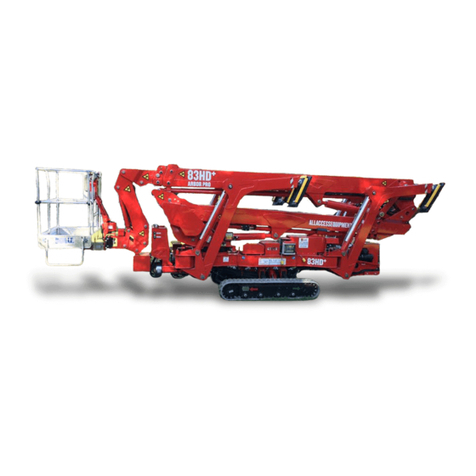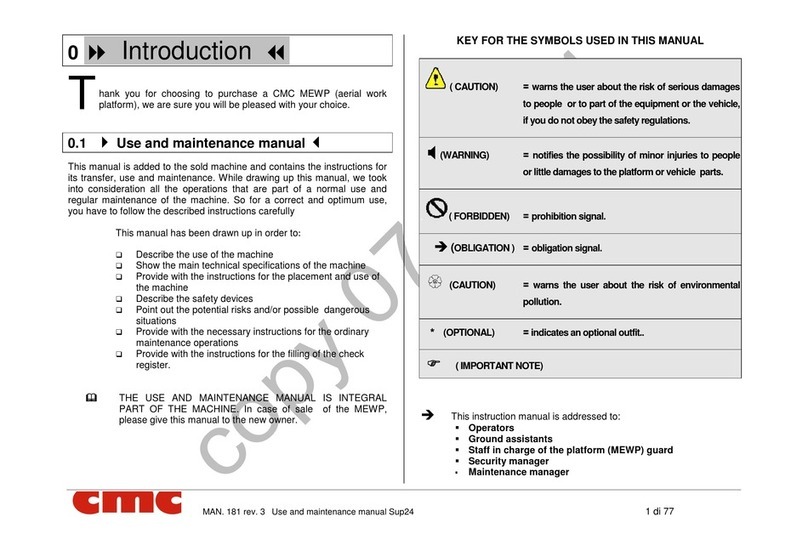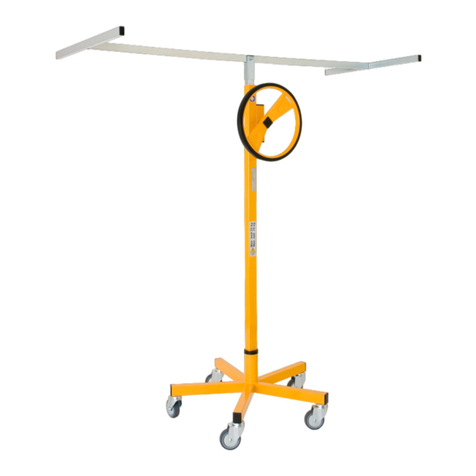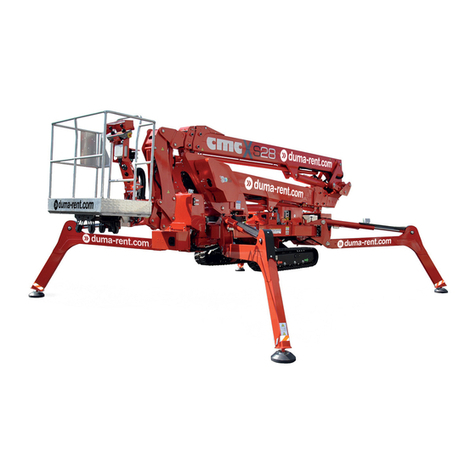MAN.234 Rev.3 ENG - Use and maintenance manual S19HD PRO page
4
of
83
1 Specifications
1.1
Technical sheet
PERFORMANCE
Max. working height 18,70 m 61.35 ft
Max. work outreach
(long area with 200/220 kg 8,60 m 28.22 ft
Max. work outreach
(long area with 80 kg 11,50 m 37.73 ft
Max. load on the basket 220 kg (USA
200 kg (CE
485 lb (USA
441 lb (CE
Turret rotation +/-355° (710° continuous
Basket rotation (*optional +90°/-87°
(P) Max. slope to stabilize 26°/49%
(W) Max. ramp slope (attack 31°/60%
(X) Max. slope to travel 17°/31%
Travel speed 0,60 - 1,38 km/h 0.37 - 0,86 mph
DIMENSIONS
(A) Basket height 1,10 m 3.61 ft
(B) Basket width 0,60/0,70 m 1.97/2.30 ft
(C) Basket length 0,80/1,20/1,40 m 2.62/3.94/4.59 ft
(D) Total length 4,85 m 15.91 ft
(F) Height in driving position 1,99 m 6.53 ft
(G) Total width (without basket 0,90 m 2.95 ft
(H) Clearance from the ground
in transport configuration 0,18 m 0.59 ft
(H’) Max. height to stabilize 1,00 m 3.28 ft
(H’’) Max. height to climb over
an obstacle
0,50 m
1.64 ft
Tracks (l x h 1,75 x 0,25 m 5.74 x 0.82 ft
Width tracks adjustment
(*optional 0,90/1,30 m 2.95/4.27 ft
(J) Max. longitudinal stabilization 4,14 m 13.58 ft
(K) Max. cross stabilization 3,54 m 11.61 ft
(N) Min. longitudinal stabilization 3,54 m 11.61 ft
(O) Min. cross stabilization 2,72 m 8.92 ft
Intermediate cross stabilization 3,12 m 10.24 ft
Outriggers plate Ø 0,18 m 0.59 ft
WEIGHT AND PRESSURES
Total weight 2617 kg 5769 lb
(R) Max. pressure on the foot 6,6 Kg/cm²
(64,72 N/cm² 93.87 lb/in
2
(S) Max. pressure on the track 0,17 Kg/cm²
(1,67 N/cm² 2.42 lb/in
2
(T) Max. pressure in travel 400 Kg/m²
(3,92 KN/m² 81.93 lb/ft
2
(U) Max. pressure in work
(4 feet opened
228 Kg/m²
(2,24 KN/m² 46.70 lb/ft
2
(V) Max. pressure in work
(4 feet closed
242 Kg/m²
(2,38 KN/m² 49.57 lb/ft
2
POWERS
Standard hydraulic feed 1 Honda GX390 petrol, 8.7 kW (11.7 HP ,
3600 rpm
*Optional feeds
2 Yanmar L100V diesel, 6.8 kW (9.1 HP ,
3600 rpm
3 Honda iGX390 petrol, 8.7 kW (11.7
HP , 3600 rpm
4 Kubota Z602-E4B diesel, 10.8 kW (14.5
HP , 3200 rpm
5 Electric engine 110/120/230 V
6 Motor G0901306, 9 kW, 48 V, with
lithium batteries 160 Ah
7 Hybrid version
Fuel tank capacity 6,1/15 l

































